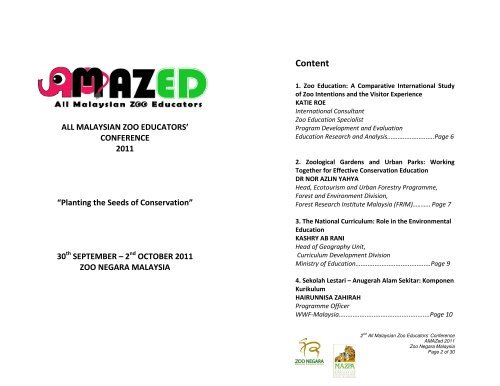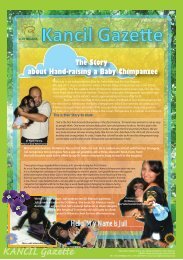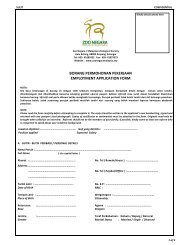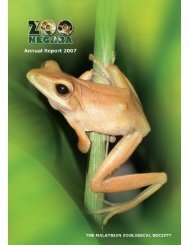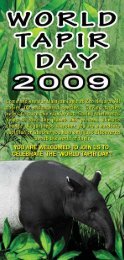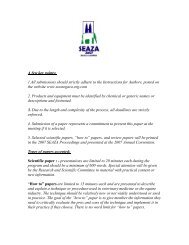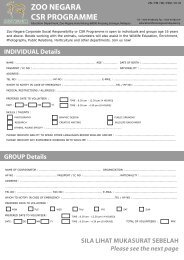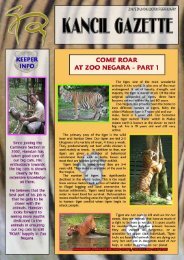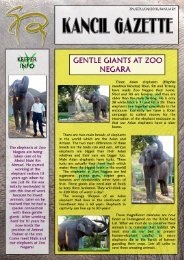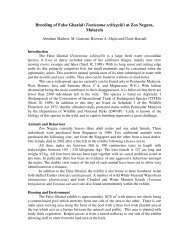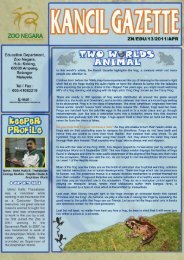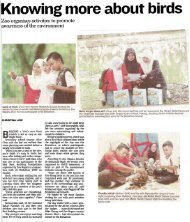Download - Zoo Negara
Download - Zoo Negara
Download - Zoo Negara
You also want an ePaper? Increase the reach of your titles
YUMPU automatically turns print PDFs into web optimized ePapers that Google loves.
Content<br />
ALL MALAYSIAN ZOO EDUCATORS’<br />
CONFERENCE<br />
2011<br />
“Planting the Seeds of Conservation”<br />
30 th SEPTEMBER – 2 nd OCTOBER 2011<br />
ZOO NEGARA MALAYSIA<br />
1. <strong>Zoo</strong> Education: A Comparative International Study<br />
of <strong>Zoo</strong> Intentions and the Visitor Experience<br />
KATIE ROE<br />
International Consultant<br />
<strong>Zoo</strong> Education Specialist<br />
Program Development and Evaluation<br />
Education Research and Analysis...........................Page 6<br />
2. <strong>Zoo</strong>logical Gardens and Urban Parks: Working<br />
Together for Effective Conservation Education<br />
DR NOR AZLIN YAHYA<br />
Head, Ecotourism and Urban Forestry Programme,<br />
Forest and Environment Division,<br />
Forest Research Institute Malaysia (FRIM)……….. Page 7<br />
3. The National Curriculum: Role in the Environmental<br />
Education<br />
KASHRY AB RANI<br />
Head of Geography Unit,<br />
Curriculum Development Division<br />
Ministry of Education...........................................Page 9<br />
4. Sekolah Lestari – Anugerah Alam Sekitar: Komponen<br />
Kurikulum<br />
HAIRUNNISA ZAHIRAH<br />
Programme Officer<br />
WWF-Malaysia....................................................Page 10<br />
2 nd All Malaysian <strong>Zoo</strong> Educators’ Conference<br />
AMAZed 2011<br />
<strong>Zoo</strong> <strong>Negara</strong> Malaysia<br />
Page 2 of 30
5. Sabah Environmental Education Network (SEEN):<br />
Our Story<br />
NURFAEZIANE NORDIN<br />
Environment Control Officer<br />
Environment Protection Department<br />
Sabah Environmental Education Network<br />
(SEEN)...................................................................Page 11<br />
6. Education Development in Gombak and Nurturing<br />
Conservation Through Education<br />
SAIFUL AZLAN OTHMAN<br />
Assistant Officer<br />
(English Secondary)<br />
Pejabat Pelajaran Daerah Gombak......................Page 12<br />
7. AMAZed for Training the Trainers in <strong>Zoo</strong> Education<br />
JUNAIDI OMAR<br />
Education Department<br />
<strong>Zoo</strong> <strong>Negara</strong> Malaysia.........................................Page 13<br />
10. Wildlife signage: It’s time for better approach<br />
NORZAINAH OMAR<br />
Educator<br />
Aquaria KLCC......................................................Page 17<br />
11. The Wildlife Conservation Act 2010: A Brief<br />
Introduction to <strong>Zoo</strong> Compliances<br />
SHAMSUDDIN OSMAN<br />
Principal Assistant Director<br />
Law & Enforcement Division<br />
Department of Wildlife and National Parks (PERHILITAN)<br />
Ministry of Natural Resources and<br />
Environment.........................................................Page 18<br />
12. The Illegal Wildlife Trade – How <strong>Zoo</strong> Educators can<br />
make a real difference<br />
CLAIRE BEASTALL Co-author : RENEE YEE<br />
Training & Capacity Building<br />
TRAFFIC Southeast Asia........................................Page 19<br />
8. <strong>Zoo</strong> Discovery: Malaysian Endangered Journey<br />
EDWINA LIM TEEN<br />
Education Executive<br />
Education Department<br />
<strong>Zoo</strong> <strong>Negara</strong> Malaysia..........................................Page 15<br />
13. Bats and Us: Are we so different<br />
DR CHRISTINE FLETCHER<br />
Research Officer<br />
Head of Forest Ecology Branch<br />
Forest Research Institute Malaysia (FRIM)..........Page 21<br />
9. Program Pendidikan di <strong>Zoo</strong> Melaka<br />
CHE NURUL ASIKIN CHE NOR<br />
Assistant Wildlife Officer<br />
<strong>Zoo</strong> Melaka.........................................................Page 16<br />
2 nd All Malaysian <strong>Zoo</strong> Educators’ Conference<br />
AMAZed 2011<br />
<strong>Zoo</strong> <strong>Negara</strong> Malaysia<br />
Page 3 of 30<br />
2 nd All Malaysian <strong>Zoo</strong> Educators’ Conference<br />
AMAZed 2011<br />
<strong>Zoo</strong> <strong>Negara</strong> Malaysia<br />
Page 4 of 30
14. The Role of Volunteers in Facilitating and<br />
Promoting <strong>Zoo</strong> Education<br />
MAZRUL MAHADZIR<br />
Programme Coordinator<br />
Way Out Experiences Sdn Bhd..............................Page 22<br />
15. Enrichment as an Educational Tool<br />
KATIE McDONALD<br />
Educator<br />
Way Out Experiences Sdn Bhd.............................Page 23<br />
<strong>Zoo</strong> Education: A Comparative<br />
International Study of <strong>Zoo</strong> Intentions<br />
and the Visitor Experience<br />
KATIE ROE<br />
International Consultant<br />
<strong>Zoo</strong> Education Specialist<br />
Program Development and Evaluation<br />
Education Research and Analysis<br />
Research has shown that zoos are in a strong position to<br />
educate the general community about conservation and<br />
wildlife issues. However, few studies have been conducted to<br />
determine the level of conservation communication between<br />
the zoo and its visitors.<br />
The aim of this research is to explore zoo education to<br />
understand the relationships between the description of<br />
education missions, the implementation of education<br />
programs, or mediums, and the influence of these for zoo<br />
visitors.<br />
2 nd All Malaysian <strong>Zoo</strong> Educators’ Conference<br />
AMAZed 2011<br />
<strong>Zoo</strong> <strong>Negara</strong> Malaysia<br />
Page 5 of 30<br />
2 nd All Malaysian <strong>Zoo</strong> Educators’ Conference<br />
AMAZed 2011<br />
<strong>Zoo</strong> <strong>Negara</strong> Malaysia<br />
Page 6 of 30
<strong>Zoo</strong>logical Gardens and Urban Parks:<br />
Working Together for Effective<br />
Conservation Education<br />
DR NOR AZLIN YAHYA<br />
Head, Ecotourism and Urban Forestry Programme,<br />
Forest and Environment Division,<br />
Forest Research Institute Malaysia (FRIM)<br />
Urban parks, zoological and botanical gardens are major<br />
contributors to the physical and aesthetic quality of urban<br />
neighbourhoods. These areas provide excellent opportunities<br />
for conservation education due to the natural resources<br />
available at the sites and their accessibility to the major<br />
populations. As places of recreation and visual assets to<br />
communities, urban parks, zoological and botanical gardens<br />
can serve as excellent centres for promoting environmental<br />
messages and conservation knowledge. Conservation<br />
education is important to increase awareness and develop<br />
responsibility for sustainable management of natural<br />
resources. With the right communication method people can<br />
be made aware of the importance of the environment and<br />
their own relationship with the environment. Effective<br />
communications will change peoples’ attitude and behaviour<br />
towards the aspect of the environment that is important to<br />
them. Environmental interpretation which is about the needs<br />
to communicate technical information to non-technical<br />
audiences, are often used for effective communications in<br />
nature based recreation areas. Interpretation involves<br />
translating the technical language of a natural science field<br />
into terms and ideas that non-scientists can readily<br />
understand, and it involves doing it in a way that is<br />
entertaining and interesting to the audience. Interpretation is<br />
an educational activity, which aims to reveal meanings and<br />
relationship through the use of original objects, by firsthand<br />
experience and by illustrative media. <strong>Zoo</strong>logical gardens and<br />
botanical parks have abundant wealth of natural resources<br />
that should be utilized to emphasis the importance of<br />
sustainable resource management and the relationship of<br />
plants, animals and human. This paper describes the<br />
importance of practicing effective interpretation methods to<br />
enhance visitors’ awareness and to encourage positive<br />
behavioural changes towards conservation of biodiversity<br />
resources.<br />
2 nd All Malaysian <strong>Zoo</strong> Educators’ Conference<br />
AMAZed 2011<br />
<strong>Zoo</strong> <strong>Negara</strong> Malaysia<br />
Page 7 of 30<br />
2 nd All Malaysian <strong>Zoo</strong> Educators’ Conference<br />
AMAZed 2011<br />
<strong>Zoo</strong> <strong>Negara</strong> Malaysia<br />
Page 8 of 30
The National Curriculum:<br />
Role in the Environmental Education<br />
KASHRY AB RANI<br />
Head of Geography Unit<br />
Curriculum Development Division<br />
Ministry of Education<br />
Sekolah Lestari – Anugerah Alam<br />
Sekitar: Komponen Kurikulum<br />
HAIRUNNISA ZAHIRAH<br />
Programme Officer<br />
WWF-Malaysia<br />
The Environmental Education Programme in the Malaysian<br />
Curriculum was introduced in 1992 with aims to improve the quality<br />
of both the life of the people and the environment as well as<br />
emphasize on sustainable development through understanding and<br />
wise management of all the natural resources. This programme<br />
spans from the pre-school level up to the secondary school level. It<br />
uses the approach of integrated learning where lessons are designed<br />
to incorporate knowledge, skills and values to give students a more<br />
relevant and meaningful learning explore in planning their lessons.<br />
Elements of Environmental Education are taught across the<br />
curriculum as well as being discussed specifically in subjects like<br />
Geography and Science. To aid the teachers, the Curriculum<br />
Development Division has come up with guidebooks with sample<br />
lesson plans and guidelines on how to infuse elements of<br />
Environmental Education in their classes. The Ministry of Education<br />
encourages collaboration and smart partnerships with various<br />
government bodies as well as NGO’s for curriculum and cocurriculum<br />
activities involving students and teachers. However, this<br />
programme has its share of obstacles namely in the form of<br />
perception and attitude of the school administrations and teachers,<br />
financial constraints, non extensive monitoring of the<br />
implementation and the lack of exposure to the concept of<br />
Environmental Education. It is hoped through education and<br />
policies, positive changes regarding the environment could be made<br />
every day.<br />
The Sekolah Lestari-Anugerah Alam Sekitar: Komponen<br />
Kurikulum project as is it officially known by its partner, the<br />
Curriculum Development Department (CDD) of Ministry of<br />
Education (MOE) was developed to produce a comprehensive<br />
Environmental Education (EE) Model, curriculum component<br />
that can be replicated throughout secondary schools in<br />
Malaysia by 2014. This project also has links with other<br />
important stakeholders such as the departments under MOE,<br />
Ministry of Natural Resources and Environment (NRE),<br />
academic institutions, nature education centres and<br />
environmental Non-governmental Organisations (NGOs). The<br />
objectives of this EE model which is to develop EE teaching<br />
aids and resource materials for schools, to facilitate teachers<br />
and education officers in carrying out EE programmes and<br />
ultimately to see behavioural change in students.<br />
2 nd All Malaysian <strong>Zoo</strong> Educators’ Conference<br />
AMAZed 2011<br />
<strong>Zoo</strong> <strong>Negara</strong> Malaysia<br />
Page 9 of 30<br />
2 nd All Malaysian <strong>Zoo</strong> Educators’ Conference<br />
AMAZed 2011<br />
<strong>Zoo</strong> <strong>Negara</strong> Malaysia<br />
Page 10 of 30
Sabah Environmental Education<br />
Network (SEEN): Our Story<br />
NURFAEZIANE NORDIN<br />
Environment Control Officer<br />
Environment Protection Department<br />
Sabah Environmental Education Network (SEEN)<br />
Education Development in Gombak<br />
and Nurturing Conservation Through<br />
Education<br />
SAIFUL AZLAN OTHMAN<br />
Assistant Officer<br />
(English Secondary)<br />
Pejabat Pelajaran Daerah Gombak<br />
This paper presents the background of Sabah Environmental<br />
Education Network (SEEN), successful programmes through<br />
networking and lessons learned in enhancing environmental<br />
education in Sabah. SEEN was launched on 17 March 2005<br />
with the aim to enhance environmental education,<br />
communication and awareness efforts in Sabah through<br />
networking, cooperation and coordination among all<br />
members. Currently, SEEN has 35 members from the<br />
government sector, educational institutions, nongovernmental<br />
organisations and private sector. Since its<br />
establishment, SEEN members have carried out various<br />
environmental education programmes such as EE Races,<br />
radio talks and trainings through sharing of resources such as<br />
funding, expertise and logistics. Members of SEEN were<br />
directly involved in the formulation of the Sabah<br />
Environmental Education Policy which was launched in<br />
November 2009. The policy provides guidance to all sectors in<br />
implementing environmental education programmes in<br />
Sabah.<br />
The presentation will be about how Gombak is progressing in<br />
terms of education. There will be brief explanation on what<br />
the district has achieved in education for the past 2 years.<br />
The explanation will be based on the district performance in<br />
public examinations as well as on how Gombak is<br />
implementing the Government Transformation Programme<br />
especially in fulfilling the key performance indicators as<br />
transpired in NKRA.<br />
In line with the theme of the conference, there will be a<br />
thought sharing on how education generally and the schools<br />
and the district education office especially have helped to<br />
actually educating and nurturing conservation among school<br />
children in our own ways.<br />
2 nd All Malaysian <strong>Zoo</strong> Educators’ Conference<br />
AMAZed 2011<br />
<strong>Zoo</strong> <strong>Negara</strong> Malaysia<br />
Page 11 of 30<br />
2 nd All Malaysian <strong>Zoo</strong> Educators’ Conference<br />
AMAZed 2011<br />
<strong>Zoo</strong> <strong>Negara</strong> Malaysia<br />
Page 12 of 30
AMAZed for Training the Trainers in<br />
<strong>Zoo</strong> Education<br />
JUNAIDI OMAR<br />
Education Department<br />
<strong>Zoo</strong> <strong>Negara</strong> Malaysia<br />
One of the missions of <strong>Zoo</strong> Education is to be the most<br />
important resource for <strong>Zoo</strong> Educators in Malaysia among<br />
learners, school teachers, volunteers and general public.<br />
AMAZed or ‘All Malaysian <strong>Zoo</strong> Educators’ was selected as a<br />
new title for MAZPA-education team. It began when <strong>Zoo</strong><br />
<strong>Negara</strong>’s Education Department started to host the First<br />
MAZPA-EDU Conference. AMAZed was then introduced in<br />
2010 with aims to allow networking and business<br />
opportunities, organizing future events with various<br />
Malaysian educators and to act as a platform for knowledgesharing<br />
on conservation education and environmental issues.<br />
This platform also a tool for generate more guidance to<br />
provide a beginning training ground for Malaysian zoo<br />
educators as well as sparking their interest in initiating and<br />
improving the environmental education programmes.<br />
this actually fits in their needs. By working constantly and<br />
trying to persuade the teachers to see the learning design<br />
layout based on further discussion prior to the visit allow this<br />
situation to encourage a team work and long term symbiotic<br />
relationship. Both parties striving to achieve the same goal at<br />
the end of the day as the zoo will be providing the activity,<br />
space and animals whereby the schools provide the audience.<br />
For the purpose of this presentation, it is hoped that we can<br />
put very much effort together in providing a series of<br />
comprehensive trainings for trainers in wildlife awareness<br />
and its ecosystem through interactive approach within the<br />
zoo ground to achieve an ultimate goal.<br />
Through organizing the environmental education programme,<br />
it will assist the educators especially teachers to instil<br />
knowledge among their students. The programme must be<br />
relevant to the latest curriculum syllabus and the aims of the<br />
schools related to meet their current topic requirement. The<br />
<strong>Zoo</strong> Educators can offer a learning experience with wildlife<br />
ecosystem background which meet the schools require, but<br />
2 nd All Malaysian <strong>Zoo</strong> Educators’ Conference<br />
AMAZed 2011<br />
<strong>Zoo</strong> <strong>Negara</strong> Malaysia<br />
Page 13 of 30<br />
2 nd All Malaysian <strong>Zoo</strong> Educators’ Conference<br />
AMAZed 2011<br />
<strong>Zoo</strong> <strong>Negara</strong> Malaysia<br />
Page 14 of 30
<strong>Zoo</strong> Discovery :<br />
Malaysian Endangered Journey<br />
EDWINA LIM TEEN<br />
Education Executive<br />
Education Department<br />
<strong>Zoo</strong> <strong>Negara</strong> Malaysia<br />
Situated near the equator belt, Malaysia is known for its hot<br />
and wet climate. The country receives plenty of sun and rain<br />
all year round which supports one of the richest plant and<br />
animal habitats in the world- the tropical rainforest.<br />
According to WWF Malaysia, the rainforests of Southeast Asia<br />
are believed to be the oldest and among the most biologically<br />
diverse in the world.<br />
The tropical rainforest in Malaysia is well-known for its<br />
unique flora and fauna. It is the home for both the wildlife<br />
and the indigenous people (Orang Asli, Penan, Iban, Orang<br />
Ulu). For those who live in the urban city, we depend on the<br />
forest for water, timber and fruits.<br />
The existence of wildlife is often linked with the rainforest<br />
ecosystem but we forget that as human, we are also part of<br />
the ecosystem. The importance and existence of the<br />
Malaysian endangered animals and how the educators in the<br />
zoo approached the future generation will be discussed in<br />
this conference.<br />
Program Pendidikan <strong>Zoo</strong> Melaka<br />
CHE NURUL ASIKIN CHE NOR<br />
Assistant Wildlife Officer<br />
<strong>Zoo</strong> Melaka<br />
Pembentangan kertas kerja Program Pendidikan <strong>Zoo</strong> Melaka adalah<br />
berkaitan latarbelakang bahagian pendidikan dan halatuju yang ingin<br />
dicapai oleh <strong>Zoo</strong> Melaka khususnya. Pembentangan ini membawa<br />
audien untuk lebih memahami peranan, fungsi dan pengisian<br />
program pendidikan yang telah dijalankan pada tahun 2011 di <strong>Zoo</strong><br />
Melaka. Bahagian Pendidikan dan Pengembangan <strong>Zoo</strong> Melaka terdiri<br />
daripada 3 unit kecil iaitu Pendidikan, Papan Tanda, Taksidermi dan<br />
Promosi. Jumlah ahli pasukan adalah seramai 10 orang staft. Unit ini<br />
telah bermula dari sebuah unit kecil pada tahun 90an. Pada waktu<br />
itu, program yang diadakan hanyalah pameran dan road tour sahaja.<br />
<strong>Zoo</strong> Melaka sentiasa peka dan bermotivasi untuk menyahut saranan<br />
konservasi biodiversiti dalam usaha menyampaikan mesej kepada<br />
orang awam tentang kepentingan elemen biodiversiti dan<br />
penggunaan sumber secara mampan. Antara aktiviti <strong>Zoo</strong> Melaka<br />
yang dijalankan ouside/luaran dan inside/dalaman. Bagi aktiviti<br />
ousite/luaran adalah Road Tour <strong>Zoo</strong> Melaka ke Sekolah-sekolah iaitu<br />
dengan memberi ceramah mengenai pendidikan konservasi<br />
biodiversiti dan peranan <strong>Zoo</strong> Melaka sebagai pusat konservasi<br />
hidupan liar, mengadakan pameran, kuiz hidupan liar dan tayangan<br />
video mengenai konservasi hidupan liar. Manakala, bagi<br />
inside/dalaman aktiviti iaitu lawatan dari Tadika, Sekolah Rendah<br />
dan Menengah / IPTA / IPTS / Persatuan/Agensi2 ke <strong>Zoo</strong> melaka<br />
dengan menjalankan aktiviti Green Heart (Gotong-royong),<br />
Explorace <strong>Zoo</strong> Melaka, Enrichment Program, ceramah, Wildlife Talk<br />
oleh Keeper serta kuiz & Mari Berwarna. <strong>Zoo</strong> Melaka mensasarkan<br />
penglibatan menyeluruh oleh sekolah-sekolah, IPTA/IPTS/Agensi2<br />
yang terlibat & orang awam untuk lebih peka dan menyayangi<br />
hidupan liar. <strong>Zoo</strong> Melaka memfocuskan tanggungjawab sosial<br />
masyarakat terhadap konservasi hidupan liar.<br />
2 nd All Malaysian <strong>Zoo</strong> Educators’ Conference<br />
AMAZed 2011<br />
<strong>Zoo</strong> <strong>Negara</strong> Malaysia<br />
Page 15 of 30<br />
2 nd All Malaysian <strong>Zoo</strong> Educators’ Conference<br />
AMAZed 2011<br />
<strong>Zoo</strong> <strong>Negara</strong> Malaysia<br />
Page 16 of 30
Wildlife signage: It’s time for better<br />
approach<br />
NORZAINAH OMAR<br />
Educator<br />
Aquaria KLCC<br />
The Wildlife Conservation Act 2010:<br />
A Brief Introduction to <strong>Zoo</strong><br />
Compliances<br />
SHAMSUDDIN OSMAN<br />
Principal Assistant Director<br />
Law & Enforcement Division<br />
Department of Wildlife and National Parks (PERHILITAN)<br />
Ministry of Natural Resources and Environment<br />
Have you ever wondered why often people do not read signs<br />
in <strong>Zoo</strong>/Aquarium Are we all assuming that people in general<br />
are lazy, illiterate or not interested in learning It’s time to<br />
put a stop to blame the visitors for not reading our signage!<br />
It’s time for all educators to come into realization the “wow”<br />
factors and wiped out the absence in producing an interactive<br />
signage! Let’s discover the criteria in producing new age<br />
signage thru this presentation. Wildlife Signage: It’s time for<br />
better approach to exhibit interpretation.<br />
The Wildlife Conservation Act 2010 [Act 716] has come into<br />
force on 28 December 2010. It is a new legislation that<br />
replacing the Protection of Wild Life Act 1972 [Act 76] which<br />
then is repeal. This new law has been formulated to cater the<br />
current needs of wildlife conservation. A wider scope of<br />
wildlife protection and enforcement have been abode as to<br />
ensure the country fauna heritage if protected and<br />
conserved. Activities involving wildlife which are listed under<br />
the Schedule requires licence, permit or special permit. This<br />
tool of conservation approach is important in ensuring that<br />
every wildlife that is keep, hunt or breed is recorded. One<br />
aspect of conservation that required permit is the operation<br />
of zoo. The general public know zoo is a place that wildlife are<br />
place for viewing and at the same time promote education on<br />
wildlife behaviours, habitats and conservation. In order to<br />
make sure the welfare of all animals kept in zoo a at its<br />
highest level, all zoo operators need to comply to<br />
requirement of the rules and regulation under the Wildlife<br />
Conservation Act.<br />
2 nd All Malaysian <strong>Zoo</strong> Educators’ Conference<br />
AMAZed 2011<br />
<strong>Zoo</strong> <strong>Negara</strong> Malaysia<br />
Page 17 of 30<br />
2 nd All Malaysian <strong>Zoo</strong> Educators’ Conference<br />
AMAZed 2011<br />
<strong>Zoo</strong> <strong>Negara</strong> Malaysia<br />
Page 18 of 30
The Illegal Wildlife Trade – How <strong>Zoo</strong><br />
Educators can make a real difference<br />
CLAIRE BEASTALL Co-author : RENEE YEE<br />
Training & Capacity Building<br />
TRAFFIC Southeast Asia<br />
Illegal trade is recognised as one of the major threats to<br />
wildlife in Southeast Asia. Wildlife is traded for a variety of<br />
purposes throughout the world. Some of this is legal and<br />
sustainable, but a worrying proportion is not.<br />
<strong>Zoo</strong> educators are in a unique position to publicise the<br />
impacts of the illegal trade in wildlife. This information will<br />
help zoo visitors and the general public make decisions that<br />
protect what we still have. Examples will be provided on the<br />
estimated extent of this trade and why we should care about<br />
it.<br />
many traditional medicine practitioners. Taking endangered<br />
species as medicine is a choice.<br />
Lastly we come to pets. Many of the species available in the<br />
past in Malaysian pet shops have been illegally collected from<br />
the wild and imported and sold illegally. The choice of a pet<br />
animal is one which zoo educators are perhaps best placed to<br />
change. The Malaysian authorities have made some huge<br />
seizures of live animals destined for the country’s pet trade<br />
over the past couple of years.<br />
Good zoos and good zoo educators can play a vital role in<br />
increasing awareness and influencing the opinions and<br />
behaviour of the public. Maximising this influence will surely<br />
help to better reach your conservation and education goals.<br />
In Southeast Asia, wild animals are used for food, traditional<br />
medicine and increasingly as pets. It should also be noted<br />
that a number of irresponsible zoos have been implicated in<br />
the illegal wildlife trade.<br />
What was once seen as attainable for very few rich and<br />
powerful individuals is, as incomes rise, increasingly within<br />
the reach of more and more people. The use of wildlife as<br />
food can have implications beyond the species on the plate.<br />
The more wild boar and wild deer that we eat, the fewer<br />
remain in the forest for predators such as tigers.<br />
The trade in wildlife for traditional medicine involves some of<br />
the rarest species on earth. Whilst beliefs may be long held,<br />
there are substitutes available for these which are offered by<br />
2 nd All Malaysian <strong>Zoo</strong> Educators’ Conference<br />
AMAZed 2011<br />
<strong>Zoo</strong> <strong>Negara</strong> Malaysia<br />
Page 19 of 30<br />
2 nd All Malaysian <strong>Zoo</strong> Educators’ Conference<br />
AMAZed 2011<br />
<strong>Zoo</strong> <strong>Negara</strong> Malaysia<br />
Page 20 of 30
Bats and Us: Are we so different<br />
DR CHRISTINE FLETCHER<br />
Research Officer<br />
Head of Forest Ecology Branch<br />
Forest Research Institute Malaysia (FRIM)<br />
The Role of Volunteers in Facilitating<br />
and Promoting <strong>Zoo</strong> Education<br />
MAZRUL MAHADZIR<br />
Programme Coordinator<br />
Way Out Experiences Sdn Bhd<br />
Harbouring 10% of all bat species, Malaysia is a hotspot for<br />
bat diversity. Yet they are often falsely persecuted, mainly<br />
due to mis-information and awareness of their importance in<br />
the balance of nature. While bats are unique in many ways,<br />
they are also very similar to humans, physically and<br />
behaviour. They are warm-blooded mammals that gives birth<br />
their young. Some live in close-knit families or friends while<br />
some like the solitary life – a behavior we can easily relate to.<br />
Their skeletal structure can be strikingly familiar to the<br />
human bones. Extensive research in understanding their<br />
ecological needs would not be effective without effective<br />
conservation efforts. Education and awareness is an<br />
important tool to change the public’s perception and assist in<br />
conservation efforts of bats and their habitat. This paper<br />
highlights the ecology of bats, its conservation and shares<br />
insights on education approaches.<br />
The presentation will discuss about role that can be play by<br />
volunteers in zoo education. It will look at <strong>Zoo</strong> <strong>Negara</strong> as an<br />
example as <strong>Zoo</strong> <strong>Negara</strong> received lots of volunteers from<br />
various organizations like schools, universities, corporate<br />
companies and also individuals.<br />
We will look at different groups of volunteers that come from<br />
various backgrounds and nationality with different set of skills<br />
and knowledge. The zoo can use their skills in promoting zoo<br />
education by disseminating info to the visitors, help with<br />
ideas on education materials like signage and leaflet and<br />
engage with enrichment.<br />
2 nd All Malaysian <strong>Zoo</strong> Educators’ Conference<br />
AMAZed 2011<br />
<strong>Zoo</strong> <strong>Negara</strong> Malaysia<br />
Page 21 of 30<br />
2 nd All Malaysian <strong>Zoo</strong> Educators’ Conference<br />
AMAZed 2011<br />
<strong>Zoo</strong> <strong>Negara</strong> Malaysia<br />
Page 22 of 30
Enrichment as an Educational Tool<br />
KATIE McDONALD<br />
Programme Facilitator<br />
Way Out Experiences Sdn Bhd<br />
Climbing, scratching, digging, foraging, rubbing, chewing,<br />
stalking, scent marking and problem solving are just a few of<br />
the many natural behaviours animals show when living in the<br />
complex and stimulating environment of their natural<br />
habitat. But what happens when these animals live in zoos<br />
How do the people responsible for the animals’ welfare<br />
recreate situations that will encourage natural behaviours<br />
particular animal species, before encouraging them to apply<br />
what they have learn by designing and making enrichment.<br />
Students then get an opportunity to observe their enrichment<br />
given to the animals and we are able to facilitate higher level<br />
thinking as we get them to evaluate the success of their<br />
design and discuss re-design for the next time.<br />
By using enrichment as an educational tool, we are thus able<br />
to combine world-class teaching methods with up-to date<br />
enrichment protocol. The result is cutting edge zoo education<br />
which helps improve captive animal welfare at the same time<br />
as providing and fun-filled and hands on experiences for zoo<br />
visitors.<br />
For the zoological community at large, enrichment is the<br />
word that describes the approaches and principals adopted<br />
to improve the wellbeing of animals in our care, whether they<br />
are furry, feathery or scaly. In good zoos, enrichment is part<br />
of everyday animal care and is as important as husbandry and<br />
veterinary practice. There are only two prerequisites to it<br />
being successful - the first is a knowledge of a particular<br />
species natural history and wild ecology; the second a desire<br />
to make enrichment happen.<br />
For many zoo educators, enrichment represents an exciting<br />
but often under-utilised tool, which can serve the needs of<br />
many groups of zoo visitors. The average tourist gains an<br />
exposure to daily enrichment activities by watching keepers<br />
both making and implementing enrichment. This can be<br />
taken to the next level by inviting zoo visitors themselves to<br />
take part in enrichment; an education technique which is<br />
especially valuable when applied to school groups.<br />
By teaching the techniques of animal observation we allow<br />
students to first gain knowledge and understanding of the<br />
2 nd All Malaysian <strong>Zoo</strong> Educators’ Conference<br />
AMAZed 2011<br />
<strong>Zoo</strong> <strong>Negara</strong> Malaysia<br />
Page 23 of 30<br />
2 nd All Malaysian <strong>Zoo</strong> Educators’ Conference<br />
AMAZed 2011<br />
<strong>Zoo</strong> <strong>Negara</strong> Malaysia<br />
Page 24 of 30
Itinerary<br />
Day 1, Friday<br />
30 Sep 2011<br />
MORNING SESSION<br />
8.00 am Arrival & Registration<br />
8.30 am Teacher Workshop<br />
9.30 am Group Assignment<br />
10.30 am Coffee Break<br />
11.00 am Group Presentation<br />
12.00 pm Discussion & Feedback<br />
12.30 pm Lunch & Break<br />
Adjourn<br />
AFTERNOON SESSION<br />
3.00 pm Arrival & Registration<br />
3.30 pm Welcoming Address<br />
Opening Remarks<br />
by Chairman of MAZPA<br />
4.00 pm Key Note Speaker I Presentation<br />
Theme Overview<br />
<strong>Zoo</strong> Education: A Comparative<br />
International Study of <strong>Zoo</strong> Intentions<br />
and the Visitor Experience<br />
BY KATIE ROE<br />
4.30 pm Key Note Speaker II Presentation<br />
<strong>Zoo</strong>logical Gardens and Urban Parks:<br />
Working Together for Effective<br />
Conservation Education<br />
BY DR NOR AZLIN YAHYA<br />
5.00 pm Press Conference & Coffee Break<br />
6.00 pm Ice Breaking Session<br />
Conference Overview<br />
6.30 pm Opening Dinner & Adjourn<br />
Day 2, Saturday<br />
1 Oct 2011<br />
MORNING SESSION<br />
8.00 am Arrival & Registration<br />
8.30 am Paper Presentation 1<br />
The National Curriculum: Role<br />
in the Environmental<br />
Education<br />
BY KASHRY AB RANI<br />
9.00 am Paper Presentation 2<br />
Sekolah Lestari – Anugerah<br />
Alam Sekitar: Komponen<br />
Kurikulum<br />
BY HAIRUNNISA ZAHIRAH<br />
2 nd All Malaysian <strong>Zoo</strong> Educators’ Conference<br />
AMAZed 2011<br />
<strong>Zoo</strong> <strong>Negara</strong> Malaysia<br />
Page 25 of 30<br />
2 nd All Malaysian <strong>Zoo</strong> Educators’ Conference<br />
AMAZed 2011<br />
<strong>Zoo</strong> <strong>Negara</strong> Malaysia<br />
Page 26 of 30
9.30 am Paper Presentation 3<br />
Sabah Environmental<br />
Education Network (SEEN): Our<br />
Story. BY NURFAEZIANE<br />
NORDIN<br />
10.00 am Paper Presentation 4<br />
Education Development in<br />
Gombak and Nurturing<br />
Conservation Through<br />
Education<br />
BY SAIFUL AZLAN OTHMAN<br />
10.30 am Q & A Session<br />
10.45 am Coffee Break<br />
11.15 am Paper Presentation 5<br />
AMAZed for Training the<br />
Trainers in <strong>Zoo</strong> Education<br />
BY JUNAIDI OMAR<br />
11.45 am Paper Presentation 6<br />
<strong>Zoo</strong> Discovery: Malaysian<br />
Endangered Journey<br />
BY EDWINA LIM TEEN<br />
1.00 pm Lunch & Break<br />
AFTERNOON SESSION<br />
2.00 pm Paper Presentation 8<br />
Wildlife signage: It’s time for<br />
better approach<br />
BY NORZAINAH OMAR<br />
2.30 pm Paper Presentation 9<br />
The Wildlife Conservation Act<br />
2010: A Brief Introduction to<br />
<strong>Zoo</strong> Compliances<br />
BY SHAMSUDDIN OSMAN<br />
3.00 pm Paper Presentation 10<br />
The Illegal Wildlife Trade –<br />
How <strong>Zoo</strong> Educators can make a<br />
real difference<br />
CLAIRE BEASTALL Co-author :<br />
BY RENEE YEE<br />
3.30 pm Paper Presentation 11<br />
Bats and Us: Are we so<br />
different<br />
BY DR CHRISTINE FLETCHER<br />
12.15 pm Paper Presentation 7<br />
Program Pendidikan di <strong>Zoo</strong><br />
Melaka<br />
BY CHE NURUL ASIKIN CHE<br />
NOR<br />
12.45 pm Q & A Session<br />
2 nd All Malaysian <strong>Zoo</strong> Educators’ Conference<br />
AMAZed 2011<br />
<strong>Zoo</strong> <strong>Negara</strong> Malaysia<br />
Page 27 of 30<br />
2 nd All Malaysian <strong>Zoo</strong> Educators’ Conference<br />
AMAZed 2011<br />
<strong>Zoo</strong> <strong>Negara</strong> Malaysia<br />
Page 28 of 30
4.00 pm Paper Presentation 12<br />
The Role of Volunteers in<br />
Facilitating and Promoting <strong>Zoo</strong><br />
Education<br />
BY MAZRUL MAHADZIR<br />
Autograph<br />
4.30 pm Q & A Session<br />
4.45 pm Coffee Break<br />
Enrichment as an Educational<br />
Tool<br />
BY KATIE McDONALD<br />
5.00 pm Feedback & Discussion<br />
6.00 pm Closing Ceremony<br />
6.30 pm Farewell Dinner at Maluri Hotel<br />
Day 3, Sunday<br />
2 Oct 2011<br />
MORNING SESSION<br />
9.00 am Post Tour to Paya Indah<br />
Wetland, Putrajaya<br />
2 nd All Malaysian <strong>Zoo</strong> Educators’ Conference<br />
AMAZed 2011<br />
<strong>Zoo</strong> <strong>Negara</strong> Malaysia<br />
Page 29 of 30<br />
2 nd All Malaysian <strong>Zoo</strong> Educators’ Conference<br />
AMAZed 2011<br />
<strong>Zoo</strong> <strong>Negara</strong> Malaysia<br />
Page 30 of 30


